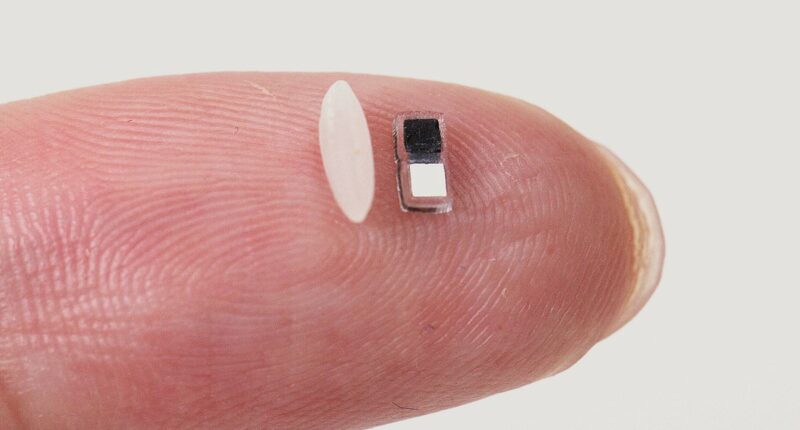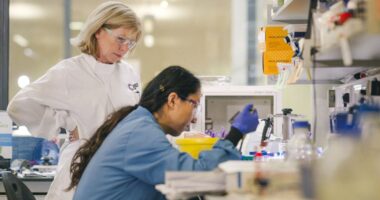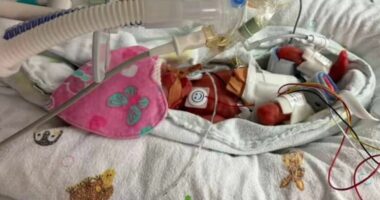Share this @internewscast.com
Roughly 1,000 NHS patients a week have a pacemaker implanted to steady their heart rate and protect them against potentially fatal abnormal rhythms.
Since the first one was used in Sweden in 1958, the devices are thought to have saved tens of thousands of lives by reducing the risk of a cardiac arrest.
But the matchbox-sized implants – which are attached to the heart by two or more leads –are not entirely risk-free.
They can cause infection, blood clots and nerve damage (during surgery to put them in) – and can even stop working inside the body if leads become dislodged or broken.
Now researchers at Northwestern University in Illinois, US, have developed a pacemaker tinier than a grain of rice that can be injected into the heart through the skin – without the need for surgery.
What’s more, it has no leads and, rather than having to be surgically removed at a later date, as current ones do, it dissolves into tiny fragments that are eventually flushed out of the body as waste.
The new pacemaker was the brainchild of scientists developing a better way of monitoring the hearts of babies who had undergone life-saving cardiac surgery.
More than 6,000 babies a year in the UK are born with a congenital heart defect. Many require surgery before being fitted with a temporary pacemaker to monitor heart rhythm during their recovery – surgeons then remove it.

Professor Francisco Leyva-Leon, a cardiologist at Queen Elizabeth Hospital in Birmingham, said the new device could revolutionise heart monitoring

The tiny pacemaker – smaller than a grain of rice – can be inserted non-invasively using a syringe
This kind of temporary pacemaker is also used in adults recovering from heart surgery or who suffer bradycardia – a sudden slowing of heart rate due to inflammation of the heart muscle or heart surgery complications.
It consists of a pulse generator, which has a battery and a tiny computer circuit – and one or more wires that attach to the heart.
If the pacemaker senses the heart has missed a beat, or is beating too slowly, it sends signals at a steady rate. If the heartbeat is normal, no signals are sent.
Although generally safe, the temporary insertion of wires and a pacemaker can go horribly wrong.
In one high-profile example, astronaut Neil Armstrong died in 2012 from complications after the removal of temporary pacemaker wires put in place during surgery to clear a blocked coronary artery.
A subsequent review found he had suffered internal bleeding and a sharp drop in blood pressure arising from the procedure.
The new pacemaker could reduce the risk of such life-threatening complications. Small enough to fit into a syringe, it has an electrode in it but no battery. Instead, it’s powered by two metals that, when they come into contact with blood or other body fluids, spark a chemical reaction that produces enough energy to drive the implant.
Meanwhile, a tiny plastic disc is stuck on the skin on the chest above the heart – this has a sensor that detects when the heart is beating irregularly.
When it detects this, it immediately fires pulses of infrared light through the skin, bone and muscle in the chest wall to turn on the pacemaker – restoring the heart to its normal rate, before switching the pacemaker off again.
The pacemaker is made from biodegradable materials that dissolve after several weeks or months (the exact time is still subject to research) – then the particles pass out of the body as waste.
This avoids the risk of infection and scar tissue forming from surgery to remove it.
But it is not meant to replace permanent pacemakers, where patients with chronic heart rhythm problems have them for life.
Findings published recently in the journal Nature showed the tiny, dissolving pacemaker worked well in animals, quickly correcting abnormalities in heart rhythm.
‘We have developed what is, to our knowledge, the world’s smallest pacemaker,’ said John Rogers, a professor of materials science and engineering at Northwestern University, who led the study. He expects the device will enter clinical trials within two to three years.
One possible future use, he said, is to inject several of the miniature pacemakers into different parts of the heart – rather than having electrodes in one spot, as is currently done. This would give a more precise picture of the heart’s electrical activity and what treatments would correct any problems.
Other slimmed-down pacemakers are already finding their way into NHS use.
In January, doctors at Castle Hill Hospital in East Yorkshire fitted a new wireless pacemaker – smaller than a AAA battery – into a man who had suffered repeated problems with conventional pacemakers.
Mike Wills, from Kirton in Lindsey, North Lincolnshire, collapsed on more than one occasion when electronic devices – such as supermarket tills and mobile phones – disrupted signals from his pacemaker. It’s hoped his scaled-down implant will be less susceptible to interference.
Commenting on the new dissolving pacemaker, Professor Francisco Leyva-Leon, a cardiologist at Queen Elizabeth Hospital in Birmingham, said it could revolutionise heart monitoring.
‘It is potentially ground-breaking,’ he told Good Health. ‘Currently, when you have a pacemaker put in there is a risk of infection [from the surgery], but that would be much reduced if you could inject it straight into the heart.’
Professor Gerry Stansby, a consultant vascular surgeon at Newcastle upon Tyne NHS Hospitals Trust, added: ‘This is definitely a step forward. The fact that it fully dissolves and could be so easily inserted by injection is particularly helpful in babies, where any type of surgery or invasive procedure can have complications.’













